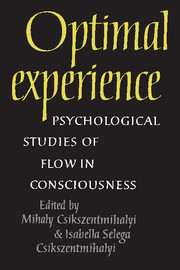Book contents
- Frontmatter
- Contents
- Acknowledgments
- Contributors
- I A THEORETICAL MODEL OF OPTIMAL EXPERIENCE
- 1 Introduction
- 2 The flow experience and its significance for human psychology
- 3 Sociological implications of the flow experience
- 4 Flow and biocultural evolution
- II VARIETIES OF THE FLOW EXPERIENCE
- III FLOW AS A WAY OF LIFE
- IV THE MEASUREMENT OF FLOW IN EVERYDAY LIFE
- References
- Name index
- Subject index
1 - Introduction
Published online by Cambridge University Press: 05 June 2012
- Frontmatter
- Contents
- Acknowledgments
- Contributors
- I A THEORETICAL MODEL OF OPTIMAL EXPERIENCE
- 1 Introduction
- 2 The flow experience and its significance for human psychology
- 3 Sociological implications of the flow experience
- 4 Flow and biocultural evolution
- II VARIETIES OF THE FLOW EXPERIENCE
- III FLOW AS A WAY OF LIFE
- IV THE MEASUREMENT OF FLOW IN EVERYDAY LIFE
- References
- Name index
- Subject index
Summary
Some ten years ago the first publications reporting studies of what we have called the “flow experience” appeared in print, beginning with an article in the Journal of Humanistic Psychology and then the book Beyond Boredom and Anxiety (Csikszentmihalyi 1975a, 1975b). In the relatively short span of time since those unheralded beginnings, scholars in a variety of disciplines have found the concept of an optimal state of experience theoretically useful. A great amount of research has accumulated during the decade, and some of the results are now being applied in educational, clinical, and commercial settings. Flow has become a technical term in the field of intrinsic motivation. This introduction briefly reviews the events related to the development of this concept, and the rest of the volume presents some of the most representative and important contributions to the study of the flow experience during these crucial initial years.
The prehistory of the flow concept: before 1975
I was led to investigate the range of experiences that eventually became known as flow by certain observations I had made in the course of my doctoral research with a group of male artists (Csikszentmihalyi 1965; Getzels & Csikszentmihalyi 1976). The artists I studied spent hour after hour each day painting or sculpting with great concentration. They obviously enjoyed their work immensely, and thought it was the most important thing in the world. Yet it was quite typical for an artist to lose all interest in the painting he had spent so much time and effort working on as soon as it was finished.
- Type
- Chapter
- Information
- Optimal ExperiencePsychological Studies of Flow in Consciousness, pp. 3 - 14Publisher: Cambridge University PressPrint publication year: 1988
- 42
- Cited by



